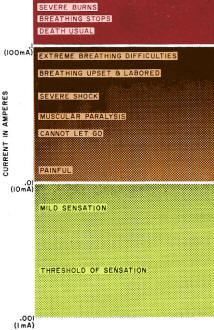|
January 1972 Popular Electronics
 Table of Contents
Table of Contents
Wax nostalgic about and learn from the history of early electronics. See articles
from
Popular Electronics,
published October 1954 - April 1985. All copyrights are hereby acknowledged.
|
Those of us who have been
working for a long time around electricity with exposed circuit components are well
aware that as little as one-tenth of an ampere (1/10 A) can produce a lethal
reaction, particularly if the current path runs through the heart (i.e.,
hand-to-hand). Some of us (moi) have even experienced a pretty significant jolt
from a high voltage vacuum tube power supply and/or from a 480 volt, three-phase
supply to an industrial motor. Fortunately, the worst damage done was to my ego and a
feeling of utter stupidity for allowing the occurrence to happen. If you are new to
the concept of electrocution, you might be inclined to wonder why, when the chart
below shows certain current levels with corresponding effects, would I mention
exposure to high voltages? The answer is that various current paths through your body
present different resistances to current flow. Higher resistance paths require higher
voltage levels in order to force current through. My rule of thumb is to treat any
voltage - AC or DC - greater than about 12 volts as being worthy of careful
treatment. That does not, however, prevent me from working on live circuits when
necessary... or when I'm too lazy to go shut off the circuit breaker.
How Much Current Is Fatal?
 The following information, supplied by Tektronics
Inc., is something we feel should be read and understood by all electronics experimenters,
technicians, hams, and engineers, regardless of what area of electronics or electrical
work they are in. The following information, supplied by Tektronics
Inc., is something we feel should be read and understood by all electronics experimenters,
technicians, hams, and engineers, regardless of what area of electronics or electrical
work they are in.
Unfortunately, most of us think that a shock of 10 kV would be more deadly than one
of 100 volts. This is not so. People have en electrocuted by ordinary 117-volt appliances
and by voltages as low as 42 volts dc! The real measure of the degree of shock is not
the voltage applied, but the amount of current forced through the body - and that need
not be very much.
While any amount of current over 10 mA is capable of producing a painful to a severe
shock (as shown in the chart), current between 100 and 200 mA can be considered lethal.
Currents above 200 mA, while producing severe burns and unconsciousness, do not usually
cause death if the victim is given immediate resuscitation (artificial respiration) .
Voltage is not a consideration; it is important only because its level and the body
resistance between the points of contact determine how much current flows. Since resistance
varies greatly, it is impossible to predict a dangerous voltage. The resistance may vary
from 1000 ohms for wet skin to over 500,000 ohms for dry skin - remembering that the
resistance from point to point under the skin may be only a few hundred ohms. Also remember
that the contact resistance decreases with time and the fatal current may be reached
rapidly.
As shown on the chart, a current as low as 20 mA is very dangerous and painful, and
the victim can't let go of the circuit. As the current approaches 100 mA, ventricular
fibrillation of the heart usually occurs. Above 200 mA, the muscular contractions are
so severe that the heart is often forcibly clamped during the shock. This clamping sometimes
protects the heart from going into ventricular fibrillation and the victim's chances
for survival are good.
Now, what lesson can we learn from all of this? First, regard all voltage sources
(even some batteries) as potential killers.
When working around electrical equipment make sure you know where you are with respect
to the voltage source. Don't lunge after fallen tools. Kill all power before diving into
circuits. Don't work when you are mentally or physically fatigued. Keep one hand in your
pocket when investigating live electrical equipment. Be particularly observant of what
you are standing on - don't work on a metal floor, damp concrete, or any other well-grounded
surface. Don't handle electrical equipment while wearing damp clothing - particularly
shoes - or when the skin is wet from water or perspiration.
In the event of an accident, either cut the voltage or get the victim away from his
contact - using some form of insulation to do the job or you will get caught too. If
the victim is unconscious and has stopped breathing, start artificial respiration at
once. Do not stop until proper medical aid has arrived.
It's not the voltage that causes the big problems, but the current level being driven
through body tissues.
Posted January 9, 2019
|









